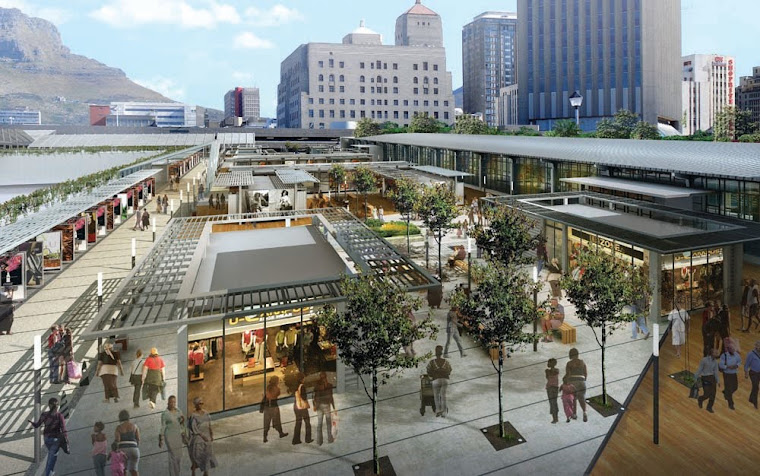
Cape Town 2 December, 2009 - The Cape Town Station R408—million Refurbishment Project, formally sanctioned by the SARCC Board of Directors in 2005, is emerging as a significant catalyst in the renewal of the Cape Town Central Business District. Cape Town Station was constructed in the early 1960’s at a time when there was significant development along the Foreshore and within the CBD. The first railway services from the new station commenced in April 1963.
Little development or expansion has been undertaken in the ensuing almost 50 years, despite the changing needs of the city and its inhabitants. Today the Cape Town Station precinct plays a pivotal role in the economic life of the City and provides an important interface between the central city- and the outlying metropolitan areas. Indeed the station is a key determinant in the quality of life of many Cape Town residents.
The refurbishment of the Cape Town Station Precinct is vital in enabling it to fulfill its rightful role in the socio-economic development of Cape Town as the Ccity embraces the challenges of growth and social integration. PROJECT INFORMANTS 2010 FIFA World Cup matches are likely to result in the largest spectator gatherings South Africa has ever experienced. Consequently, a significant improvement is necessary to ensure that the rail system, especially at stations, is able to cope with the demands, as well as catering to the needs of daily commuters.
Before the refurbishment project began, the station building had become functionally inefficient and seriously degraded, even to the point of becoming a health risk. Green Point Stadium, located within five km of the station, is in the process of being completed to host the 2010 FIFA World Cup matches to be played in Cape Town. It is expected that the soccer fans will converge on station on match days as they make their way to the stadium.
BENEFITS
In addition to the aesthetic benefits of a clean, modern station, the following also apply: • Improved operational efficiency; • Improved safety and security; • Improved information management; • Sustainability; and • Improved accessibility and ease of movement for all.
SCOPE OF THE PROJECT
Cape Town Station is divided into four precincts for the planning and designing of the construction work: The Station Forecourt
• The station forecourt comprise three open areas depicted as A, B and C in the diagram, the main concourse running from Old Marine Drive (Precinct 2) to Strand Street (Precinct 3) and a five storey tower block.
• The station forecourt is the area through which visitors will move to thestadium and therefore a priority for completion. Construction work in Precincts 2, 3 and 4 are mainly refurbishment projects although there are inter-dependencies, e.g. Precinct 4 must be completed (new trading market) to receive the informal traders currently occupying the Forecourt. The station forecourt must be open and unobstructed for 2010 to allow free movement through this space to the stadium. Main Concourse
• New ticket sale points and information desks at the entrances at Old Marine Drive and Strand Street. • Station managers’ offices and function areas located in the ticket selling point at Old Marine Drive.
• Demolishing of existing ticket offices and commercial areas to clear the concourse for free movement. • Re-tiling the floor.
• Replacing turnstiles with high-tech access gates.
• Construction of new food courts, one at each ticket selling point. Five Storey Tower Block
• Demolition, alteration of internal walls and refurbishment, except the fourth floor and the clinic, which were recently refurbished to accommodate various operational departments.
• Various operational units are to be housed in the refurbished tower block. ‘Creative’ Cape Town Space
• This is one of the major retail spaces on the station due to the excellent exposure the CBD and no direct rail operations present in this corner of the station.
• Relocation of the Long Distance Bus Facility to Precinct 2.
• Construction of an urban square with the Food Court in the Main Concourse opening onto the square.
• Demolition of internal walls, alteration and refurbishment of two storey building along Adderley Street to accommodate retail / ‘creative’ Cape Town activities and a transport museum on the first floor.
• Demolition of internal walls, alteration and refurbishment to first floor of the building along Old Marine Drive to accommodate offices and construction of a retail / ‘creative’ Cape Town activities below. Station Square
• This square is seen as an operational space as the main access to the concourse and platforms from the CBD as well as an evacuation space in the event of an emergency or disaster.
• The informal traders currently occupying the Station Square will be relocated to the Station Deck.
• Removal of the garden areas and retaining and/or relocation of some of the trees.
• Construction of hard and soft landscaping of the square to allow movement and maximum usage.
• Square to allow occasional seasonal / themed events in between rail operational peak times. Station Corner
• This is a more reflective space featuring public art works.
• Construction of a square with the Food Court in the Main Concourse spilling opening onto the square;
• Refurbishment and adjustments to the accesses down into the underground retail areas of the CBD. Old Marine Drive
• This is the long distance travel precinct featuring the long distance bus facility, Blue Train Lounge and commercial area at the lower end towards Oswald Pirow Street.
• Relocation of the Blue Train Lounge to the Parcels Building.
• Construction of new offices and ticket selling points for long distance bus operators, as well as meet & greet and waiting lounges.
• Civil works to construct new curb lines, pavements and surfaces for new sedan taxi waiting areas, two drop-and-go areas for long distance travel services, pedestrian walkways, cycle routes, parking and long distance bus terminal.
• Refurbishment of the station building facing Old Marine Drive.
• Enclosure of the long distance bus facility and possible retail on the outer edge of the enclosure and down Old Marine Drive closer to Oswald Pirow. The commercial components at the long distance bus facility and further down in Old Marine Drive are not part of the scope of the project. The intention is to investigate the possibility of sourcing capital from outside the current capital allocation. Strand Street
• This precinct consists of rail operational functions facing platform 1 and retail facing Strand Street.
• The Cape Town SAPS facility located in this precinct was built recently and is still in good condition.
• Demolition of internal walls, alterations and refurbishment to accommodate retail edge on Strand Street and rail operations facing platform 1. Rail operations on platform 1: • Facilities • Access controllers • Train Cleaners • Protection Services Station Deck
• The City of Cape Town manages the public parking areas and taxi rank in this precinct. Planning is being coordinated to allow a seamless implementation of the refurbishment of this area.
• This precinct consists of the Good Hope Concourse next to Oswald Pirow Street, Parade Concourse, train drivers- & Premier Services offices and mess facilities and traders market. • Deck civil works to waterproof the deck and install storm water and other services to serve the market
• Construction of the top structures in the market, i.e. kiosks for trading, ablution facilities, management facilities for the trading markets and solid waste recycling depository facility
• Internal demolitions, alterations and refurbishment of the Parade- and Good Hope concourses to accommodate retail and rail operational functions. The Parade concourse is in the current scope of project while the refurbishment of the Good Hope concourse depends on the airport raillink project as the terminal facility for this service will be located in the Good Hope concourse. Integrated Communication System
• An integrated communication system consisting of closed circuit television cameras, public address systems, information boards, advertising and infotainment is included in the scope of the project.
• The integrated communication system touches on one of the regional functions which is funded by the national integrated communication system project. START DATE AND END DATE The project was initiated by the then SARCC in 2005. A professional team was appointed in 2006 with the first contactors appointed towards the end of 2007. The main building contractor stepped on site on the 1st of September 2008. The 2010 elements of the project will be completed by March 2010 with some refurbishment components continuing. JOB CREATION
• 11 contracts form part of the project, translating into roughly 650 jobs with a local labour component of at least 20% ,of which at least 90% are held by previously disadvantaged individuals.
• Another three contracts have recently been awarded that will add to the employment figures above. MONEY FUNDING SOURCES CAPITAL PROVISION EXPENDITURE TO DATE PTIS 110,000,000 110,000,000 MTEF (as per PRASA Bus. Plan) 406,000,000 130,726,860 TOTAL 516,000,000 240,726,860 Project Photo Gallery Old Marine Drive Before Old Marine Drive Entrance after Station Forecourt Before Forecourt during construction Old Ticket sales New ticket sales


No comments:
Post a Comment